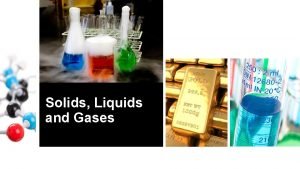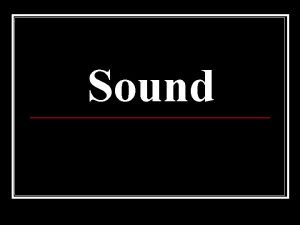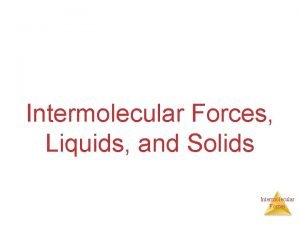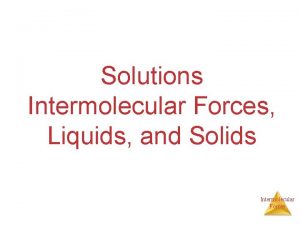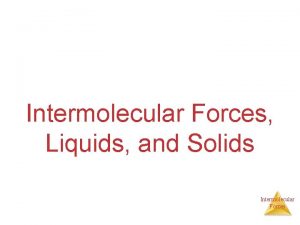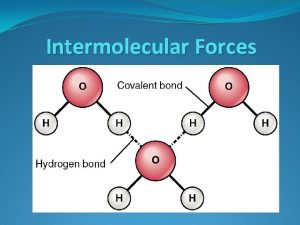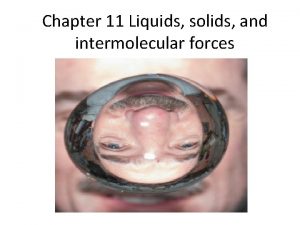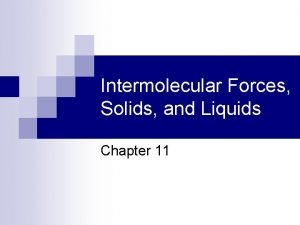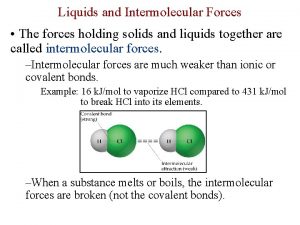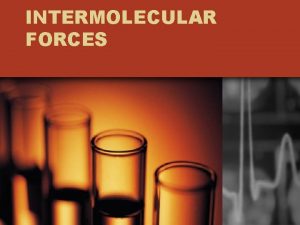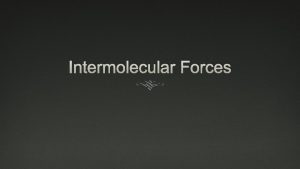Intermolecular Forces and Liquids and Solids Chapter 12


















- Slides: 18

Intermolecular Forces and Liquids and Solids Chapter 12

12. 7 The compounds Br 2 and ICl have the same number of electrons, yet Br 2 melts at -7. 2 o. C, whereas ICl melts at 27. 2 o. C. Explain. 12. 9 The binary hydrogen compounds of the Group 4 A elements are CH 4 (-162 o. C), Si. H 4 (-112 o. C), Ge. H 4 (88 o. C), and Sn. H 4 (-52 o. C). The temperature in parentheses are the corresponding boiling points. Explain the increase in boiling points from CH 4 to Sn. H 4. 12. 10 List the types of intermolecular forces that exist in each of these species: (a) benzene (C 6 H 6), (b) CH 3 Cl, (c) PF 3, (d) Na. Cl, (e) CS 2.

Intermolecular Forces Dispersion Forces (London forces) Attractive forces that arise as a result of temporary dipoles induced in atoms or molecules Instantaneous-induced dipole The strength of dispersion forces tends to increase with increased molecular weight. Larger atoms have larger electron clouds, which are easier to polarize. The tendency of an electron cloud to distort in this way is called polarizability. 12. 2

Intermolecular Forces Dispersion Forces Polarizability is the ease with which the electron distribution in the atom or molecule can be distorted. Polarizability increases with: • greater number of electrons • more diffuse electron cloud Dispersion forces usually increase with molar mass. 12. 2

What type(s) of intermolecular forces exist between each of the following molecules? HBr is a polar molecule: dipole-dipole forces. There also dispersion forces between HBr molecules. CH 4 is nonpolar: dispersion forces. SO 2 O SO 2 is a polar molecule: dipole-dipole forces. There also dispersion forces between SO 2 molecules. 12. 2

Intermolecular Forces Hydrogen bonding (H-bonding) A special kind of dipole-dipole interaction • The strength of dispersion forces tends to increase with increaseing molecular weight. • Increased strength of dispersion forces usually leads to an increased boiling point (see blue curve) • Why do the binary hydrogen compounds of Group 6 A not follow this trend?

Intermolecular Forces Hydrogen bonding (H-bonding) A special kind of dipole-dipole interaction • Why do the binary hydrogen compounds of Group 6 A not follow this trend? These molecules are polar so a dipole-dipole interaction is also operative. H 2 O, in particular is capable of a special dipole-dipole interaction that is unusually strong.

Intermolecular Forces Hydrogen Bond The hydrogen bond is a special dipole-dipole interaction between the hydrogen atom in a polar N-H, O-H, or F-H bond an electronegative O, N, or F atom. A H…B or A H…A A & B are N, O, or F 12. 2

Intermolecular Forces Hydrogen Bond The dipole-dipole interactions experienced when H is bonded to N, O, or F are unusually strong. H-bonding arises, in part, from the high electronegativity of nitrogen, oxygen, and fluorine. 12. 2

Intermolecular Forces Hydrogen Bond Fluorine is more electronegative than oxygen so it is reasonable to expect a stronger H-bond in liquid HF than in H 2 O. However, the boiling point of HF is lower than that of H 2 O, indicating a weaker H-bonding network in HF. Explain. Each H-F can participate in two H-bonds while each H 2 O can make four H-bonds. 12. 2

Summary of intermolecular forces Ion-induced dipole and dipole-induced dipole are additional types of dispersion forces.

Intermolecular forces affect properties of liquids Surface tension is the amount of energy required to stretch or increase the surface of a liquid by a unit area. Strong intermolecular forces High surface tension 12. 3

Intermolecular forces affect properties of liquids Surface tension is the amount of energy required to stretch or increase the surface of a liquid by a unit area. Surface tension allows water glider walk on water. Surface tension results from the net inward force experienced by the molecules on the surface of a liquid which causes the surface to tighten like an elastic film. 12. 3

Properties of Liquids Surface tension is responsible for capillary action. Cohesion is the intermolecular attraction between like molecules Adhesion is an attraction between unlike molecules Adhesion Cohesion water mercury 12. 3

Properties of Liquids Viscosity is a measure of a fluid’s resistance to flow. Strong intermolecular forces High viscosity 12. 3

Structure and properties of water • All life processes involve water • Excellent solvent for many ionic compounds as well as other substances capable of forming hydrogen bonds with water (i. e. , DNA) • Moderator of climate owing to a high specific heat (absorbs heat in summer and gives off heat in winter with only small changes in the temperature of water) • Unique substance in that solid ice is less dense than liquid water (usually solids are more dense than liquids) 12. 3

Water is a Unique Substance Maximum Density 4 0 C Thermal expansion Ice is less dense than water H 2 O trapping in cavities 12. 3

Solids Crystalline—high order (regular repeating pattern) Amorphous—low order
 Intermolecular vs intramolecular
Intermolecular vs intramolecular Intermolecular forces vs intramolecular forces
Intermolecular forces vs intramolecular forces Covalent bond intermolecular forces
Covalent bond intermolecular forces Chapter 14 solids liquids and gases worksheet answers
Chapter 14 solids liquids and gases worksheet answers Kinetic molecular theory of liquids and solids
Kinetic molecular theory of liquids and solids Chapter 11 - states of matter: liquids and solids
Chapter 11 - states of matter: liquids and solids Expansion of solids liquids and gases examples
Expansion of solids liquids and gases examples Solids liquids and gases section 2 properties of fluids
Solids liquids and gases section 2 properties of fluids Site:slidetodoc.com
Site:slidetodoc.com State of matter venn diagram
State of matter venn diagram Properties of a solid
Properties of a solid Solid liquid gas examples
Solid liquid gas examples Kinetic molecular theory of liquids and solids
Kinetic molecular theory of liquids and solids Liquids and solids menu
Liquids and solids menu The science duo physical and chemical changes
The science duo physical and chemical changes Liquids and solids
Liquids and solids Particle movement in solids liquids and gases
Particle movement in solids liquids and gases How does sound travel through solids liquids and gases
How does sound travel through solids liquids and gases Liquid information
Liquid information















